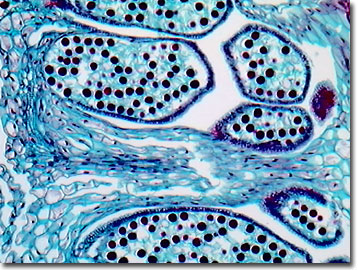Brightfield Digital Image Gallery
Horsetail (Equisetum) Mature Strobilus
Horsetails (Equisetum arvense) are hollow-stemmed plants that anchor deep into the ground by an extensive, creeping root system. Also commonly known as mare's tail, horse pipes, or snake grass, their origins reach far back into the past, some 200 million years. These living fossils thrive in wet localities such as stream banks, swamps, bogs, wet meadows, and gullies, as well as roadside ditches.

View a high magnification image of the horsetail mature strobilus.
In similarity to other ancient vascular plants, such as the spike mosses in the division Lycophyta, the only living remnants of the division Sphenophyta, Equisetum have an asexual reproductive structure, the sphenophyte cone or strobilus. Unlike the spike mosses, horsetails and their fossil ancestors are all homosporous (in effect, they make only one type of reproductive spore). Strobili form at the uppermost portion of fertile branches and are composed of sporophylls bearing a single sporangium. Dispersed by wind, the small spores germinate into small, free-living disc-shaped gametophytes that produce either archegonia (female reproductive organs) or sperm-producing antheridia. Released from the antheridia under moist conditions, the sperm cells swim through water films to reach the egg cells on the female gametophytes.
E. arvense produces two types of hollow-jointed stem. The fertile stems, tipped with the spore-bearing cone about one inch in length, emerge in early spring and die back soon after the spores are released. The spent shoots are rapidly replaced by sprouting vegetative stems bearing whorls of green, four-angled, leaf-like branches. Both varieties of shoots are maintained by food reserves that are stored in small tubers produced along the horsetails' extensive root-like system (rhizomes). This root system is actually an underground horizontal plant stem that typically penetrates deep into the soil. The tenacious rhizome allows horsetails to form dense colonies that can grow to weed-like proportions and create problems in orchards and hayfields with poorly drained soils. Although generally having very little commercial value, one species of coarse, textured horsetail, known as the scouring rush, stores a high content of silica granules in its cells and is utilized in abrasive powders for scrubbing pots and polishing wood. Horsetails are considered toxic to grazing livestock, but they also have medicinal value to humans as a diuretic, and in traditional medical practices of Native Americans and Ukrainians, as a blood-clotting promoter.
Contributing Authors
Cynthia D. Kelly, Thomas J. Fellers and Michael W. Davidson - National High Magnetic Field Laboratory, 1800 East Paul Dirac Dr., The Florida State University, Tallahassee, Florida, 32310.
BACK TO THE BRIGHTFIELD IMAGE GALLERY
BACK TO THE DIGITAL IMAGE GALLERIES
Questions or comments? Send us an email.
© 1995-2025 by Michael W. Davidson and The Florida State University. All Rights Reserved. No images, graphics, software, scripts, or applets may be reproduced or used in any manner without permission from the copyright holders. Use of this website means you agree to all of the Legal Terms and Conditions set forth by the owners.
This website is maintained by our
Graphics & Web Programming Team
in collaboration with Optical Microscopy at the
National High Magnetic Field Laboratory.
Last Modification Friday, Nov 13, 2015 at 01:19 PM
Access Count Since September 17, 2002: 27330
Visit the website of our partner in introductory microscopy education:
|
|
